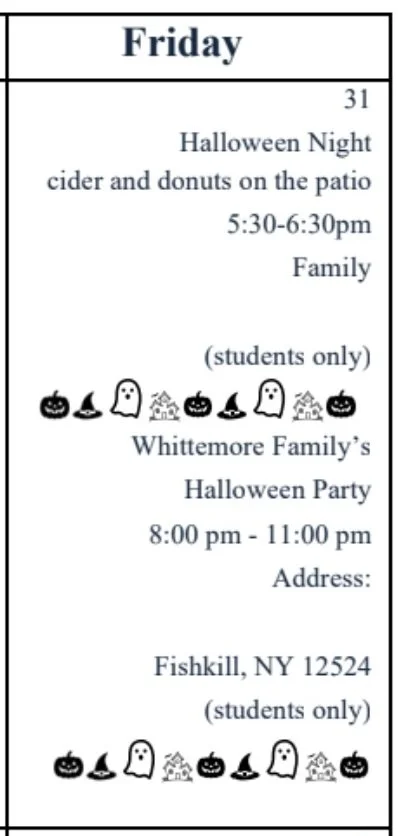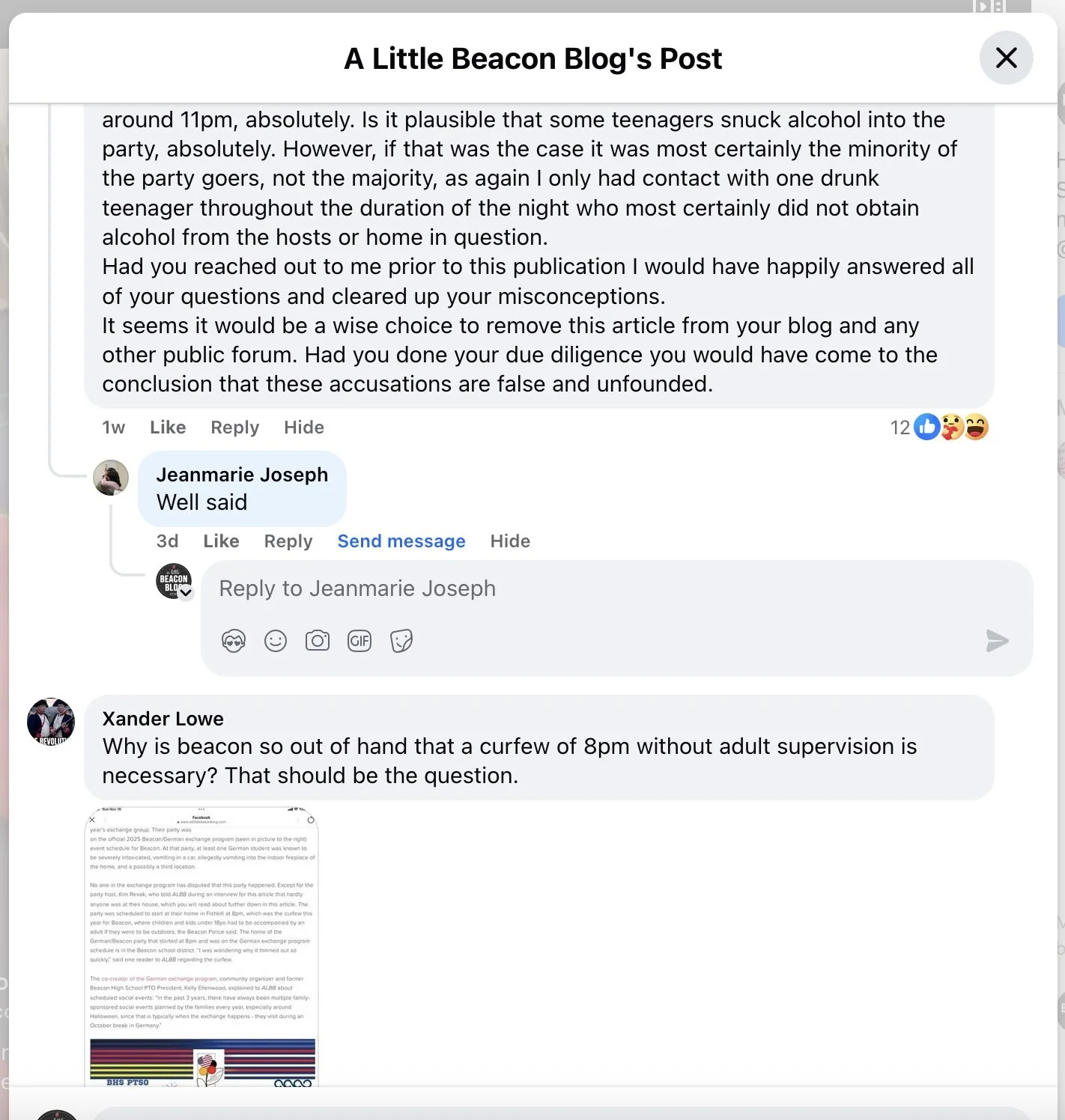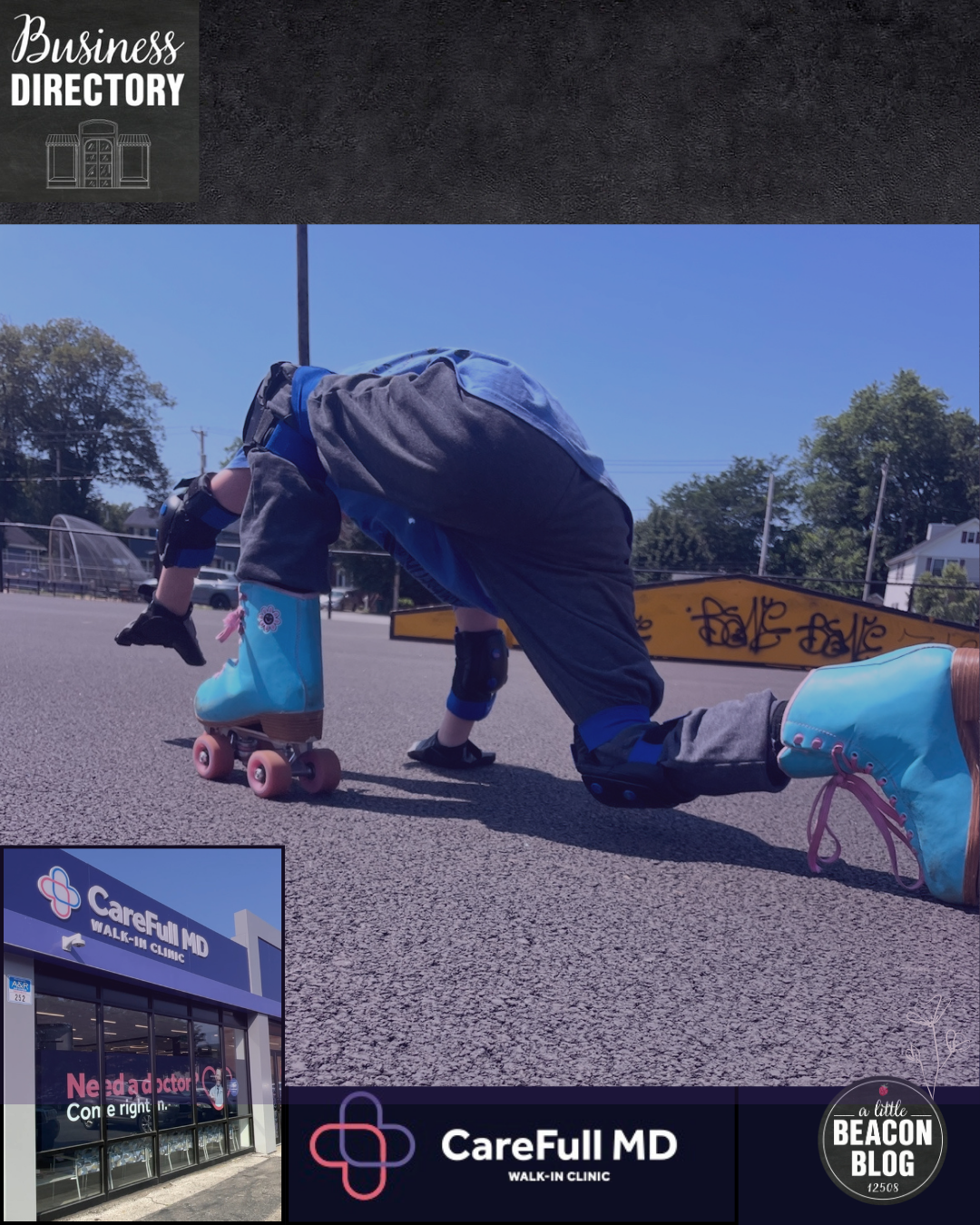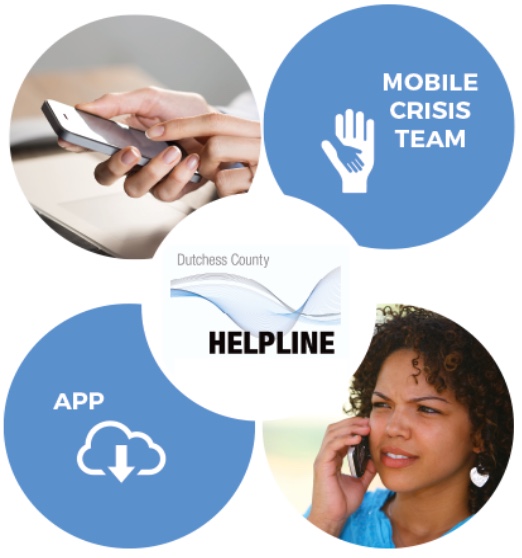Alcohol And Lack Of Supervision At Halloween Party Prompts Beacon Superintendent To Distance School Staff From German Exchange Program
/Update 11/29/2025: The response to ALBB from the host’s manager that was made after this article published has been included at the bottom of this article. It includes her description of aspects of the party, and what she said she set up for anticipated guests.
Editor’s Note: This article is partially written in the first person, as the writer, Katie Hellmuth, is also a source; one of the only sources willing to go on the record for this article. She participated in this year’s German Exchange Program between Beacon and the school in Gemering, Germany, the Max Born Gymnasium through the German American Partnership Program (GAPP).
The 2025 Beacon German Exchange Program schedule from the Beacon High School Program Coordinator. Addresses and an a different Friday gathering at a different location have been blocked out.
Superintendent Matt Landahl has ended the involvement of the Beacon High School staff with the German Exchange Program at the Beacon High School after word got out that alcohol was available to allegedly dozens of kids at a Family Halloween Party in a home in Fishkill (Beacon school district) off Red School House Road hosted by a family who had been in the program, Scott Whittemore and Kim Revak, but who were also participating via What’s App with this year’s exchange group. Their party was on the official 2025 Beacon/German exchange program (seen in picture to the right) event schedule for Beacon. At that party, at least one German student was known to be severely intoxicated, vomiting in a car, allegedly vomiting into the indoor fireplace of the home, and a possibly a third location.
No one in the exchange program has disputed that this party happened. Except for the party host, Kim Revak, who told ALBB during an interview for this article that hardly anyone was at their house, which you will read about further down in this article. The party was scheduled to start at their home in Fishkill at 8pm, which was the curfew this year for Beacon, where children and kids under 18yo had to be accompanied by an adult if they were to be outdoors, the Beacon Police said. The home of the German/Beacon party that started at 8pm and was on the German exchange program schedule is in the Beacon school district. “I was wondering why it thinned out so quickly,” said one reader to ALBB regarding the curfew.
The co-creator of the German exchange program, community organizer and former Beacon High School PTO President, Kelly Ellenwood, explained to ALBB about scheduled social events: “In the past 3 years, there have always been multiple family-sponsored social events planned by the families every year, especially around Halloween, since that is typically when the exchange happens - they visit during an October break in Germany.”
The logo for the Beacon German Exchange program, which includes the BHS PTSO, Docuware (Headquartered in Beacon), the German American Partnership Program, and Beacon High School / Max Born School in Germany.
This year, Kelly had handed off her coordinator involvement with the program to a teacher, María Margarita Calaf, and was not involved this year, as her work expanded with her co-founding of Beacon Bonfire. She told ALBB that she did not attend the Halloween Party at the Whittemore’s this year. Dr. Landahl confirmed to ALBB that for the previous 3 years, the BHS PTO ran the program, and that this fall, the Beacon High School ran the program.
He told ALBB: “For the previous three years, the BHS PTO ran the program. This fall, the High School ran the program. Insurance [for the program] is through the GAPP (German American Partnership Program) program itself.
The program offers guidance to students and teachers on how to have a successful program. Alcohol is forbidden. Here is the clause from GAPP’s literature:
Alcohol VERBOTEN (translates to “forbidden”)
“Students need to be reminded that although the legal drinking age in Germany for beer and wine is age 16, all students, regardless of age, traveling on the trip will adhere to U.S. rules, and will therefore not be allowed to drink. Set consequences as you would in your classroom and stick to them. Speak with your partner teacher to insure they speak with their students and parents.
“Remind students that even if they are not drinking, photos of them holding alcohol of any kind should not be posted on social media. Explain to the students and their parents that posting alcohol on social media could put future exchanges to Germany (and even your job) in jeopardy. Have this conversation with your partner school as well so that everyone is on the same page.”
Before We Get To The Party - What Happened After The party?
After the party that Monday after Halloween, the German teachers called for an Emergency Meeting of their students. Sources familiar with the meeting said that the German students were asked to come forward if they drank alcohol. Those who did come forward were given “one strike,” which, the sources say, contributes to expulsion from their school in Germany if they reach seven strikes total.
Those familiar with the meeting also said that the German teachers were upset with their students, as there had already been calls “from both sides” for this exchange program to end years prior, and that this incident gave fuel to the fire of that call. It was not stated why there had been such a sentiment.
American students from Beacon were not called into such a meeting, or asked to come forward if they drank alcohol. Chatter about the party among students circulated quickly in the hallways of Beacon High School, and trickled into the Middle School. Knowledge of this party was wide-spread.
Beacon parents in the exchange program are connected in a What’s App group chat. Nothing had been brought up to the Beacon parents by school leadership, and Beacon parents had not been discussing the party amongst themselves in the chat. Most, including myself, were processing what we were hearing about the Friday evening, and the developments for the German students that Monday at school. Nothing had been mentioned about the Whittemore’s accountability.
Beacon’s Mayor Lee Kyriacou recognized the Beacon/German exchange program with a Proclamation, which was covered by the Beacon Free Press.
Since the program’s inception by Kelly Ellenwood and DocuWare, whose headquarters are in Beacon at 25 Creek Drive, and the school in Germany, the Max Born Gymnasium, only accolades have been published about it. This year, on the evening of the Emergency Meeting at Beacon’s November 3rd City Council Meeting, the City of Beacon’s Mayor Lee Kyriacou issued a Proclamation for the program. The Beacon Free Press wrote about it. At the meeting, Mayor Lee said he spoke for the City Council in saying that this photo opportunity with the program was one of his favorite meetings each year.
Presenting at that meeting, teacher and chaperon from the Max Born Gymnasium school Sebastian Hess said: “It’s a pleasure to be here. Beacon feels like home. I said it before and I say it again: When you speak about homes, I want to say a special thanks to all the parents this year who host and make this program actually happen. Without you, it would be impossible and we are really, really grateful to have you.” He went on to say that this is “not something we take for granted so that so many people are willing to host students for 2 weeks.”
Later, he said to the Council: “I cannot wait to send the next group of kids, and the next kids and the next kids to make this an everlasting tradition between our two great cities.”
On Monday evening, before the City Council Meeting for the annual photo opp, one parent - me - asked the parent What’s App group, which is facilitated by the Beacon teacher leaders María Margarita Calaf and Ron Hammond, when the alcohol at the party that endangered the kids was going to be discussed. Ms. Calaf answered that it was not a school event, and that teachers were “not invited,” so was not an issue that was planned to be discussed.
Some parents responded calling for accountability of the Whittemore’s, details about the party and who provided alcohol, but Scott did not reply.
Advance Knowledge Of Alcohol At The Party
As a reporter for A Little Beacon Blog, I receive unsolicited information on a regular basis. Sometimes wild information from all sorts of places from all sorts of people. I am emailed from time to time by an older person who has issue with an employee in a now closed hospital. This person usually writes a paragraph in all caps in such grammar that even I have a hard time following their stream of consciousness. But their feelings are real and big, and I usually wait until I hear unsolicited matching information from other sources before pursuing anything.
I have been emailed about a situation of board members, invited to and escorted into a private member social club in Beacon to accompany someone delivering legal documents to board members, and then told to leave by the opposing side without me ever saying a word. I have been invited and accepted onto a Zoom call with the City of Beacon for a civil service arbitration hearing challenging an employee to push him to get fired, where I see everyone else on the call, hear a bit of chatter, and then am asked to leave without me ever saying a word.
Similar happened in this situation with the Whittemore Halloween Party. I had been hearing that their parties, or social gatherings that involved kids, had involved alcohol. I had heard something about a party they hosted for the German exchange program the year before. And I had heard that their house was a known destination for gatherings of kids, who were seen sleeping on the downstairs floor or upstairs in beds the next day by parents who picked up their kids from casual nights out. But I did not know if this was exaggerated. Did they simply have alcohol at their house as any adult might?
All of these whispers I let pass through my ears. But, out of an abundance of caution, not knowing what was wild speculation or rumor, I made a private decision to hold my child and our German delegate student back from the party at the Whittemore’s on Halloween Night.
What Allegedly Happened At The Party
After I learned that a German student had vomited into their Beacon parent’s car upon pickup from the party, more information began trickling in. That the student had been drinking Red Bull and vodka, and had also gotten sick into an indoor fireplace in the Whittemore’s home, and a third location.
I was told that there did not seem to be other parents there, or people over the age of 21, aside from Kim Revak Whittemore and Delia, their former nanny and current manager of Plato’s Closet, the second-hand store they opened a year ago in Wappinger’s Falls. I was told that the host mother allegedly handed out cans of beer, and that kids brought their own supply of alcohol to the party from unknown sources.
While the event was scheduled for 8-11pm that night, some kids, I was told, stayed longer, getting home by 1am. Some kids grew concerned about their friends safety in getting home, I am told, and tracked their friends on the apps kids use these days to stay in touch and track each other’s locations, usually in malls or at sports destinations, to care for each other.
I was told that there was a long line for the bathroom, but that Ms. Whittemore told the kids to go to the bathroom outside, and locked the door. It was not indicated that Scott Whittemore was at the party, or if he was, that he was seen at the party. The oldest people that party attendees seemed to see, aside from Kim and Delia the manager, were older kids at Beacon High School, who I am told, grew concerned for the younger kids in lower grades who were drinking.
The only reason I knew that alcohol had been at this party at all was because I offered to throw a last minute birthday party at my house for our German student. The parent of the known intoxicated German student asked me if there would be alcohol at my party, as they had been given a vomiting child from the last party, to which I said of course not, to which they said good, because they hadn’t expected it at Friday’s party.
Has There Been A Response From The Whittemore’s?
So far, no. Weeks prior, Scott Whittemore had been on the pre-trip Zoom call, where Beacon teacher Ms. Calaf led the parents through the schedule.
When she got to the parties part of the agenda, she stated that there was to be “no alcohol.” Because I had heard whispers of alcohol at the Whittemore’s house the previous year, I looked at Scott on the Zoom call. He nodded his head slightly in agreement when Ms. Calaf stressed “no alcohol.” Another parent asked how to get their pumpkin carving party onto the official schedule, but Ms. Calaf said that the schedule was set, and that parents could offer their own social gatherings and communicate about them on What’s App.
The German delegate students returned home to Germany last Saturday afternoon. We dropped them at Beacon High School, where a Beacon school bus was to take them to the airport. The kids were sobbing. A bit unexpected, for the two weeks they spent together. It was like watching crying fans at a Beetles or Elvis concert. Then some parents began to cry. Then the kids had to keep moving onto the bus to not miss their flight back to Germany.
Scott Whittemore was at that departure, milling around with people, as if walking with parents on the soccer sidelines of a game. He seemed jovial and talkative just like any other parent.
On Monday, I collected and asked verification questions of Beacon High School program leadership, and Scott. I had his text from What’s App, but did not have Kim’s. For this article, I had separate questions for each of them.
I texted Scott, identified myself as a reporter, saying I was writing an article for ALBB, and asked the following questions, to which I received no reply:
- How many years have you participated in the German exchange program?
- Did you host a party last year for the German Exchange program?
- Were you at the party hosted at your house on Friday, October 31 that was on the program calendar?
- Was your wife Kim Revak also at the party?
- Was Delia, the manager of Plato's Closet also at the party?
- Around how many people attended?
- Was alcohol provided to guests of your party?
- Did a student vomit into or near your fireplace in your house?
- Did you or Kim give beer to anyone in the German exchange program?
- Did you as hosts allow kids who attended the party to go to the bathroom in your home? Or did you tell them to go outside to use the bathroom?
The next day, I received a text from Kim, telling me that she would be happy to speak to me about the German exchange program. She let me know that they have been involved in the program since the beginning, even during its planning stage during COVID, and have hosted 7 times. They personally began hosting in 2022, she said.
I asked her about DocuWare’s involvement, as they are the financial sponsor of the program. Plenty of articles at newspapers have been written about this, but I wanted to hear her take. She answered: “Yes DocuWare has always been involved. Without them, the program would have never got off the ground. The owners of that company were graduates of the school in Munich. DocuWare is how the relationship between Beacon and the school in Munich started. Prior to Beacon, they did their exchange with a school near Chicago.” According to a newspaper article about this, exchange programs like to come to New York.
This year, the Whittemore’s were hosting a German student, but not from the DocuWare program. “We are now hosting a student for the current school year under a different program. Growing up, Scott's family support[ed] multiple exchange programs and we, as a family, have always supported kids through programs like the ‘FreshAir Fund’, were we had under privileged kids from the city come live with us for the summer. All great programs focused on providing opportunities for kids.”
The Whittemore Denial Of The Party
Friday’s Halloween Night Schedule for the German Exchange Program Students. Addresses and an a different Friday gathering at a different location have been blocked out.
I next asked her if other parents were in attendance for their 2025 Family Halloween Party, in addition to Scott and Delia. Her response: “? Why would our Halloween have anything to do with you or the exchange program.”
I told her it was because their party was on the German exchange program schedule provided to us by the school. Her response: “Correct. Since my exchange student did not have many opportunities to socialize with the other German students, we offer a small get together for the kids from 8pm to 10pm, which included pizza, hot dogs, soda, s'mores around the fire pit, basketball/corn hole, etc. However very few kids showed up. I was told many had other plans/parties they were going to around town. Which was fine, it was a busy night with a lot going on.”
I asked her how she got my text, since I did not have her contact info. “Scott is super busy at work and just ask me to text you as I have been the one more involved with the German program.” Based on her stated involvement, I asked if she was in the What’s App group, curious if she had seen the discussion from parents that demanded accountability from them. She responded that she was not, as “tech stuff” is not her strength.
When I showed her response to a fellow parent whose kid attended the party, about how “very few kids showed up” to the Whittemore’s s’mores around the fire pit party, the parent expressed: “Wow. Just…wow!”
A parent not in the German exchange program this year was hearing details about the party, and then realized that their own kid was also at the party. It was widely attended.
As Kim and I ended our text chat, she requested that I write a positive article about the program, saying: “I would love to see an article to support the program. A lot of time, [effort] and money has gone into growing it over the years.”
New York’s Hosting Law
According to the New York based law firm Salenger, Sack, Kimmel & Bavaro: “New York’s Social Host Law, outlined in N.Y. General Obligations Law § 11-100, imposes liability on individuals over 18 who knowingly allow minors (under 21) to consume alcohol on property they own, lease, or control. This includes private residences, rental properties, and other venues. The law aims to deter underage drinking by holding hosts accountable for the safety and actions of their underage guests.”
According to the law firm, hosts have key responsibilities, and to comply with the Social Host Law, should:
Prevent Underage Drinking: Ensure that no alcohol is served to or consumed by individuals under 21.
Take Immediate Action: If underage drinking is discovered, promptly intervene by stopping the consumption and, if necessary, contacting parents or law enforcement.
Monitor Guest Behavior: Be vigilant about guests’ alcohol consumption to prevent over-intoxication and potential accidents.
Questions Asked To German Program Leadership & Party Host Parents
As a parent, and not as a reporter, I had emailed Beacon High School Principal Dr. Corey Dwyer, Dr. Landahl and Ms. Calaf the week after the party. I stated my support for the program in my first paragraph, and then went on to state how surprised I was that no one was discussing Friday night’s incident with us.
Still having a child in Middle School, I’m used to trips with Principal Soltish, where he and other teachers accompany students to Boston and DC, and update parents relentlessly. There are in-person prep meetings, constant text reminders about deadlines, and during the trip, assurances that all kids are back in their hotel rooms - and not sneaking out (at least that they know of).
This German experience - while Beacon kids did not travel - was just a shock. At least from a communication and accountability perspective. The thought of sending my child to Germany with this same set of standards was questionable. I do not know if I am the only one who emailed.
Dr. Dwyer sent a message to Beacon parents a short time later, saying:
“I want to begin by thanking you for opening your homes and welcoming our visiting students from Germering. We are appreciative of the time and energy you have devoted to providing them with a memorable experience.
“We have become aware that a social gathering attended by both Beacon and Germering students, where alcohol was present, took place on Halloween night. No school officials from Beacon or Germering were present, and the school had no knowledge that alcohol would be served at this gathering. While the district cannot be responsible for what takes place in private homes in situations where no school official is present, we take seriously our responsibility to facilitate a positive, educational, and culturally enriching experience for all participants. We were disappointed to learn about this situation.
“As you know, this was a parent- and PTSO-led exchange for the past three years. Our priority for these last few days is to help ensure a safe and enjoyable experience for all participants. After our visiting students return home, we will take time to carefully review this year’s exchange. We will be in touch in the coming weeks.”
The Decision For ALBB TO WRite This Article
The amount of peer pressure from some of my adult friends within this exchange program to not write this article has been immense. I was told it was “not newsworthy,” would get the program canceled, and would harm kids who were at the party, as well as negatively impact the social comfort of my own family. Meanwhile, other friends have asked me why the police have not been called on the adult party hosts.
Writing this article was nowhere near my Editorial Calendar Bingo Card. Several other issues are scheduled for long-form deep dives. We are in the middle of a SNAP hunger crisis, and for the school, I had planned to write an article celebrating the new students brought onto the Beacon Board of Education.
A parent from the program reached out to me to ask me to write a letter of support for the program to Dr. Dwyer. I let the parent know that I already had vocalized my support, and also my concern. The parent then asked me not to write an article, as ALBB’s article would surely end the program. I responded that any article done here would not end the program, it would be providing information, and that the Whittemore’s behavior would be what ended the program, if that happened, which I thought unlikely, because exchange programs exist all over the world and are common and enriching for students.
The parent pressed me further after I spoke about having prior hints of the potential for alcohol. The parent expressed that they wished I had told them, so that parents could have made different choices sending their kids to the party. I responded that I only had speculative knowledge, and did not want to pass gossip. They disagreed.
I told them that they were asking me for a conflicting duality:
To tell them privately about my hesitation and why.
To not tell the public about what later became fact, so as not to jeopardize the program.
I then told them that they were pushing me very hard, harder than they were pushing the school or party hosts for accountability, and that I make choices for my own life and that of my children, and do not extend my choices as assumptions onto others.
My core guided me to publishing. If I was receiving this much pressure from my adult friends, I was reminded what pressure kids feel when they are in social settings that they may or may not want to be in. So I published. In the hopes of bringing this to light in case it is helpful to others.
What is the Future Of The German Exchange Program?
Dr. Landahl emailed Beacon parents on Friday afternoon. He said:
“I am writing to invite you to a meeting on Wednesday, November 19, at 7:00 p.m. in the LGI room at Beacon High School to discuss potential ways the program can move forward in June/July.
“Corey Dwyer reached out to you on November 4th and stated that we would review the program in light of the party at a family’s house on Halloween, where students and exchange students accessed alcohol. The party highlights a significant challenge in the program, specifically that we are unable to supervise students either here in Beacon or in Germany outside of school hours or official school events. After speaking at length with Dr. Dwyer and the teachers involved in the program, both past and present, I have determined that it is not appropriate for our staff to be involved in the travel to Germany either officially as representatives of the district or unofficially as paid by the BHS PTO, as has been done in the past. This is something with which we are all in agreement.
“I know this is disappointing news, as many of you have reached out to me over the past few days, highlighting the successes of the program, and I appreciate hearing those stories. I know that the program has positively impacted dozens of students over the past three years. The teachers involved have also shared these positive stories with me.
“The purpose of the meeting on November 19th will be to explore the possibility of students still visiting their host families in Germany this summer, with parents and/or community members overseeing the program and providing supervision. It will also be a time to share any thoughts or concerns you may have.”
After this email went out, two parents went to the What’s App group, demanding accountability of the Whittemore’s. One parent tagged Scott in the app, but Scott did not respond.
How are the kids handling this?
From what I could tell, the German delegates were updating their Beacon parents with what their German teachers were telling them. Some German and Beacon students were surprised that the Whittemore’s had not been brought up at all as being an issue that needed dealt with. One German student said that it felt…they searched for the word in English and found it: “irresponsible.”
The kids are very upset that the program has been distanced from the school. When the Germans arrived at the Beacon High School the night they flew in, the Beacon kids were ecstatic. Jumping around like cheerleaders, and whisking “their Germans” away to feed them dinner at 10pm.
The kids are communicating to see if they can still go to Germany in any way. As a parent, I am exploring possibilities to connect with our German delegate family privately, not within a group.
There was GAPP insurance connected to this experience, which might have been impacted by the breach of alcohol. As a reporter, I am awaiting an answer on that. Otherwise, as a parent, I am balancing my student’s desire to explore Europe with her new German friend, and other Beacon friends if that coordinates.
Also - budget. That’s a lot of dollars. I just paid mortgage today. Which was a big win. But the electric heating bill is coming.
Back to work!
Editorial Update 11/29/2025:
After this article published, several comments were left at Facebook from people who said they had knowledge of the party. One such person was Delia Kelly, who was mentioned earlier in this article when Scott Whittemore was reached out to to confirm if himself, his wife and their employee were present at their house. While Scott did not answer, and his wife did tell ALBB the following, which was included at the beginning of this article: “Correct. Since my exchange student did not have many opportunities to socialize with the other German students, we offer a small get together for the kids from 8pm to 10pm, which included pizza, hot dogs, soda, s'mores around the fire pit, basketball/corn hole, etc. However very few kids showed up. I was told many had other plans/parties they were going to around town. Which was fine, it was a busy night with a lot going on.”
After the article published, their employee, Delia Kelly, told ALBB on Facebook that she helped set up for the party, “arriving at the home around 9:30pm Halloween night,” to set up food. “At a little after 10pm” she said, “I got the outdoor fires started, for anyone who may have wanted to roast marshmallows or keep warm as it was a bit chilly that night. At this point, no one had arrived yet.” Weeks earlier, her employer Kim told ALBB that the gathering they offered would end at 10pm, and that few showed up at all.
Delia went on to address the intoxicated teenager: “Is it plausible that some teenagers snuck alcohol into the party, absolutely. However, if that was the case it was most certainly the minority of the party goers, not the majority, as again I only had contact with one drunk teenager throughout the duration of the night who most certainly did not obtain alcohol from the hosts or home in question.”































































